The Foundation of Freedom is the Courage of Ordinary People History  On Line On Line
|
Leadership failure, haphazard disarmament, misguided training objectives, Intelligence failures ... these were root causes of the Korean tragedy.
We face those same dangers today as we stand down from the Middle East. This site offers insights bitterly learned sixty years ago, to help avoid them.
Understanding these photographic insights can be helped by a brief review:
The Korean War, 1950-1953 |
|
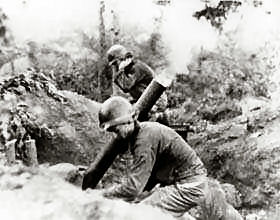
|
An M2 4.2 inch mortar crew, members of HeavyWeapons Company, 21st Infantry Regiment, fires on the attacking North Korean 4th Division near Chochiwan, 11 July 1950. The 4th Division had routed our 21st Regiment's 3rd Battalion before noon that day, killing the 3rd's CO and costing it 60 percent of its strength. With the infantry in retreat, these positions were soon also overrun and these mortarmen escaped as best they could, if they could.
|
A gun crew checks their equipment just before the Kum River Line disaster. 15 July 1950. On July 16, The N.K. 3d Division fixed our 19th Infantry by frontal attack while enveloping their flanks, established a roadblock behind them, and decisively won the battle. These tactics characterized NK and Chinese attacks throughout the war. Our defeat, as so often in 1950, was largely due to our engaged forces lacking a mobile reserve to meet enemy penetrations or flanking movements.
| 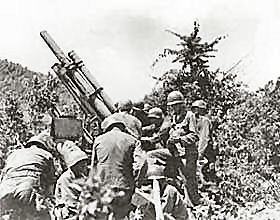 |
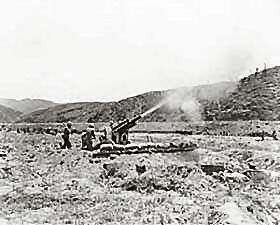
|
A 105-mm howitzer in action against the advancing North Korean invaders, who had just taken Taejon. 22 July 1950.
|
American gunners blasting Yongdok, northeast of Pusan, with their 105-mm howitzer. 23 July 1950.
| 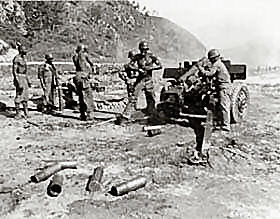
|
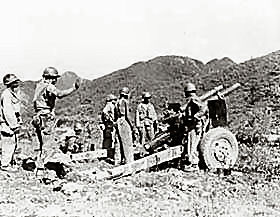
| SC344383 - Artillery gun crew waits for the signal to fire on the enemy, somewhere in Korea.
25 July 1950. Korea.
Signal Corps Photo #8A/FEC-50-4713 (Breeding)
|
SC344384 - KOREAN CONFLICT
American artillery firing on Communist-led North Koreans, somewhere in Korea.
25 July 1950. Korea.
Signal Corps Photo #8A/FEC-50-4712 (Breeding)
| 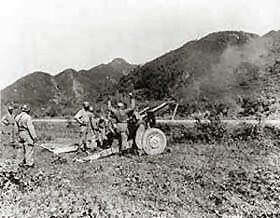
|
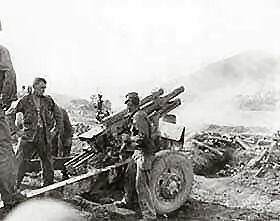
| SC344638 - KOREAN CONFLICT
105-mm howitzer in action against the Communist-led North Korean invaders.
26 July 1950. Korea.
Signal Corps Photo #8A/FEC-50-4839 (Wayne)
|
The Pusan Perimeter, 8/1/50 to 9/16/50 After our initial disasters at the Kum River Line and Taejon, 8th Army continued to fall back into a defendible perimeter around the vital port city of Pusan. There, although suffering other defeats and losing ground in the Northern section, the Army was reinforced, the Marine Brigade landed and kept the NK from advancing across the Naktong in the west, and the perimeter was held On September 15, MacArthur would land the entire 1st Marine Division and X Corps at Inchon, far behind the N.K. lines, and shortly the war would seem over.
| 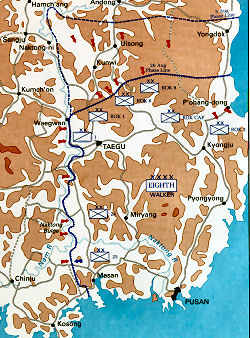
|
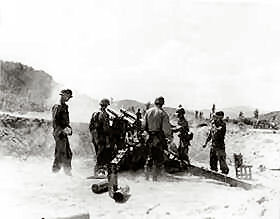
|
Battery B, 61st Field Artillery, 1st Cavalry Division, fires at North Korean positions across Pusan Perimeter Defenses along the Naktong River. L. to R., Pvt. Alvin Essary of Tuscalossa, Ala.; Pvt. Miller T. Young of Avonmore, Pa.; Pvt. Harvey L. Lewis of Porterville, Calif.; Pvt. Abel Saunders of Venton, Va.; and Cpl. Lester Mortz of Sheridan, Oregon. Waegwan, 7 August 1950.
|
Pfc. Letcher V. Gardner (Montgomery, Iowa), Co D, 8th Cavalry, 1st Cavalry Division, fires on a North Korean emplacement along the Naktong River, near Chingu. Pusan Perimeter, west of Pusan, 13 August 1950.
| 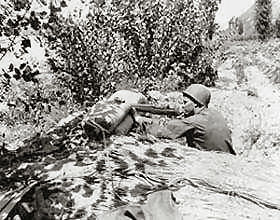
|
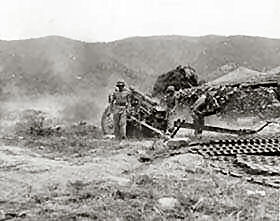
|
A Battery of the 8th F/A, 25th Division, fires a 105-mm howitzer on a North Korean road block. 22 August 1950. Throughout the 7-week battle of the Pusan Perimeter, the North Koreans attacked fiercely. Usually they would attack frontally while circling around us, block our withdrawal, then attack from all sides. However we now had developed reserves to contain these flanking attacks, and artillery to then blast apart the roadblocks.
|
SC347079 - KOREAN CONFLICT
Men of Battery A, 159th Field Arillery Battalion, fire a 105-mm howitzer in an indirect firing mission on the Korean battle line, near Uirson.
24 August 1950. Korea.
Signal Corps Photo #8A/FEC-50-7424 (Pfc. Wayne H. Weidner)
| 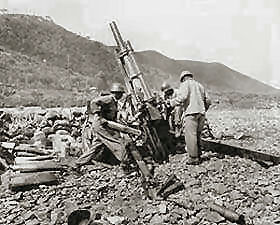
|
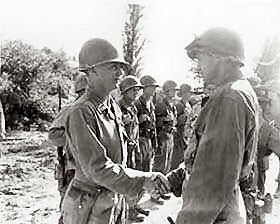
| SC346626 - KOREAN CONFLICT
Major General Hobart R. Gay, CG, 1st Cavalry Division, congratulates 2nd Lieutenant Raymond A. Whelan of Mossap, Conn., after awarding him the Silver Star for meritorious services.
25 August 1950. Korea.
Signal Corps Photo #8A/FEC-50-6908 (Cpl. Hutchinson)
|
SC346955 - KOREAN CONFLICT
A .50 Cal. Machine gun squad of Co. E, 2nd Battalion, 7th Regiment, 1st Cavalry Division, fires on North Korean patrols along the north bank of the Naktong River, Korea.
26 August 1950. Korea.
Signal Corps Photo #8A/FEC-50-7043 (Sfc. Riley)
| 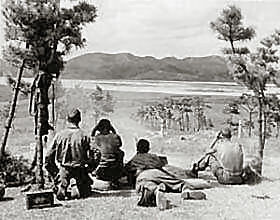
|
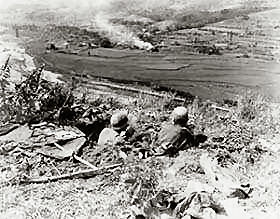
| Pfc. Robert Smith of Springfield, Colo., (left) and Pvt. Carl Fisher of Ponca, Okla., 27th Infantry Regiment, dug in and firing at North Korean positions. 4 September 1950.
|
While successfully building a fighting perimeter around Pusan to keep the enemy engaged, General MacArthur sent a powerful Naval-Air-Amphibious force around them in a dramatic invasion of the Port City of Inchon. The First Marine Division and an entire Corps was suddenly positioned in the N.K. rear. Anironic and decisive use of their own tactics. 15 September 1950.
| 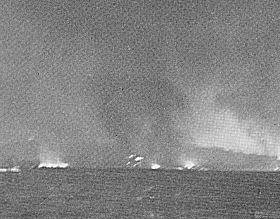
|
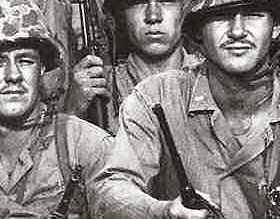
| Marine Rifle Platoon from E-2-5, 1st Marine Division, 8/50 This rifle platoon fought throughout the Pusan Perimeter battles, Inchon, acrossthe Han River to help recapture Seoul, and their survivors went on to fight their way out of the Chosin Reservoir in a series of savage tactical victories in the midst of overwhelming strategic defeat.
|
Men of the 5th RCT fire a .30 caliber machine gun at N.K. positions across the Naktong River, north of Taegu, as 8th Army prepares to break the Perimeter and drive north. 18 September 1950.
| 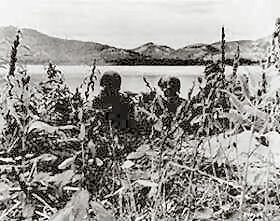
|
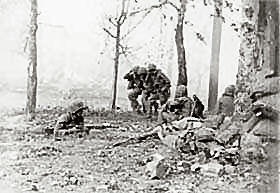
| After a heavy artillery preparation against Hill 125, menacing Fifth Marines' attack across the Han, I Company began an assault on the Hill at 0645, 20 September. Enemy fire from automatic weapons and small arms caused heavy casualties in I Company, one of their dead in the foreground, but it secured the hill, and the crossing was made. 20 September 1950.
|
SC351390 - KOREAN CONFLICT
A United States Marine suppresses North Korean sniper fire with the .45 caliber M3A1 in Seoul. September, 1950.
20 September 1950. Korea.
Signal Corps Photo #FEC-50-20508 (Strickland and Romanowski)
| 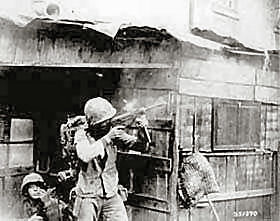
|
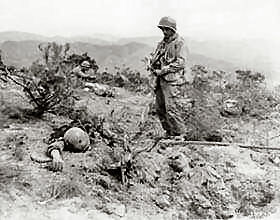
| SC349306 - KOREAN CONFLICT
Sgt. Herbert Ohio of Hilo, T.H., views the battered remains of the Communist defenders of Hill 268, which was taken by men of the 5th RCT, 1st Cavalry Division in their advance on Waegwan, Korea.
21 September 1950. Korea.
Signal Corps Photo #FEC-50-9327 (Chang)
|
SC349313 - KOREAN CONFLICT
A machine gun crew fires at fleeing Communist-led North Korean targets during heavy street fighting in the captured city of Waegwan. L-r: Pfc. Austin Dela Cruz of Honolulu; Cpl. William Purdy; Pfc. Alexander Domingo of Honolulu; and platoon leader Sgt. Robert I. Muramoto of Honolulu, T.H.
21 September 1950. Korea.
Signal Corps Photo #FEC-50-9336 (Chang)
| 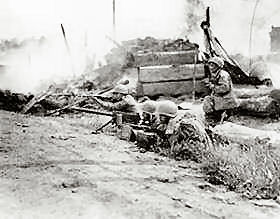
|
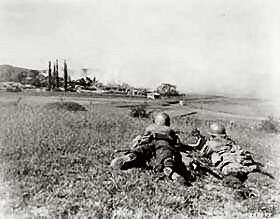
| SC349347 - KOREAN CONFLICT
A .30 caliber light machine gun crew of the 5th RCT, 1st Cav. Div., fires on Communist-led North Koreans, as they push toward Taejon, Korea.
22 September 1950. Korea.
Signal Corps Photo #8A/FEC-50-9438 (Chang)
|
ROK troops had crossed the 38th Parallel on September 30.
Wounded soldiers are evacuated (foreground) as M-4 tanks of the 5th RCT move to the front in the Kumchun area, October 6.
Sanctioned by the United Nations, on October 9 our 1st Cavalry Division led a general assault across 38th Parallel to re-unify all of Korea
| 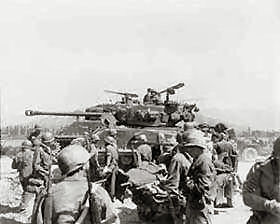
|
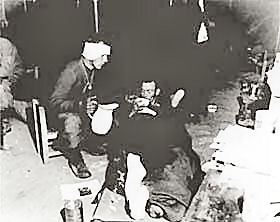
| Sfc. Louis F. Walz (left), a member of Co. E, 5th Cavalry Regiment, 1st Cavalry Divisioin, and Pfc. Raymond M. Szukla, a member of Co. G, 5th Regimental Combat Team, 24th Infantry Division, receive medical aid at the 8063rd Mobile Army Surgical Hospital, attached to I Corps in Korea. Sfc. Walz is recovering from a head wound, and Pfc. Szukla suffered a wound in the right leg while engaged in action against Communist forces.
4 November 1950.
|
In late November, 1950, hundreds of thousands of China's veteran guerilla Armies, victorious the previous year at Huai-Hai, one of the most decisive battles in history, secretly moved into North Korea to ambush our over-extended forces. Unaware, a patrol of Co. C, 65th Infantry Regiment, 3rd Infantry Division, fires light machine guns against Chinese scouts in the hills near Haejung, North Korea. 27 November. Sfc. Forsyth, who photographed the action, was wounded shortly after recording this picture.
| 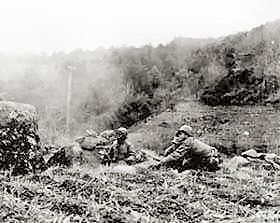
|
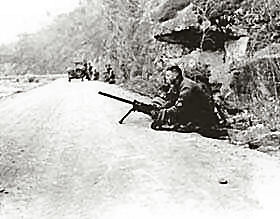
|
A machine gun team of an X Corps military police company goes into action to relieve a convoy pinned down by Chinese fire. 6 December 1950. Using frontal attacks combined with encirclement and entrapment, China's resolute forces were savagely attacking 8th Army in the west, and the Marines and X Corps in the east. Thus began the Marines' savage fight-out to evacuation at Hungnam on Christmas, 1950, and the longest retreat in the history of the US Army. |
The First On 9/12/50, my ship USS Wantuck, APD 125, stood out from Pusan, South Korea, with I/3/5 to spearhead a mighty Task Force in the brilliant assault at Inchon, and the near total destruction of North Korea's armed forces. UN forward units soon reached the Yalu and Victory appeared total. At that moment in time, given the Allied destruction of the Axis in WWII, such a result seemed almost something to take for granted. | 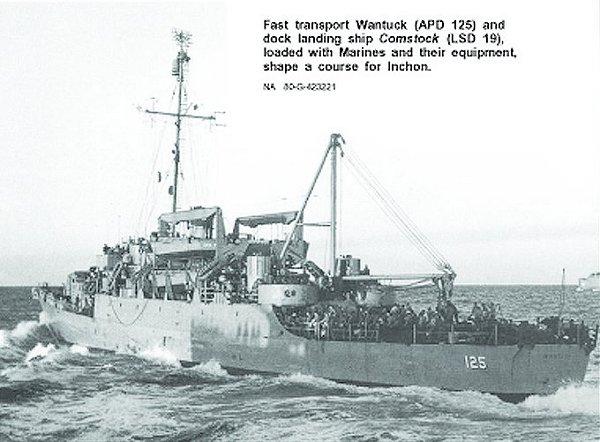
|
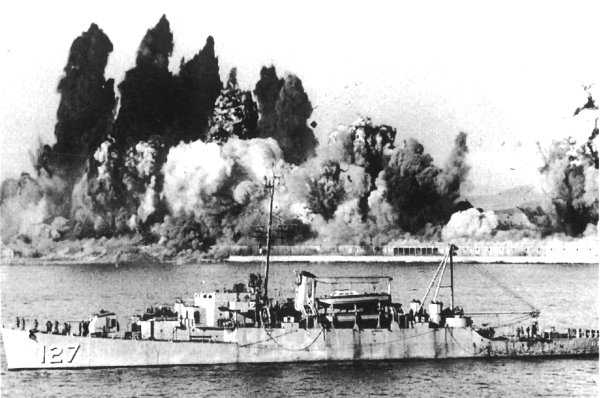
|
The Last On 12/24/50, USS Begor, APD 127, stood off at Hungnam, North Korea, as the last UN forces retreat and Demolition teams ashore blow up supplies and installations. Two Navy Special Operations Force APD actions thus sandwich one of the saddest periods in American Military History since Gettysburg. |
Causes of the Korean Tragedy ... Failure of Leadership, Intelligence and Preparation
The Foundations of Freedom are the Courage of Ordinary People and Quality of our Arms
Back to: South To The Naktong, North To The Yalu |






























